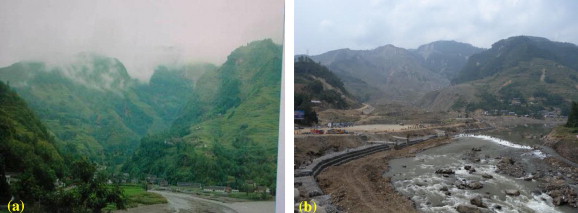11 November 2014
Review of a paper: The Donghekou landslide in China
Posted by Dave Petley
The Donghekou landslide
One of the largest landslides triggered in the remarkable 2008 Wenchuan earthquake in China occurred at Donghekou in Qingchuan County. This was a large slide – it has a volume of about 100 million cubic metres and it traveled over a distance of about 2 km. Four villages were buried, resulting in about 780 deaths. This landslide has been examined in detail in a paper, Wang et al. (2014) just published in Engineering Geology. This pair of images, whose provenance is somewhat unclear but which was reproduced in another paper on this landslide (Zhou et al. 2013) provides a before and after view of the landslide site:
.
The paper is interesting in a number of ways. First, it notes that the slope was known to be unstable and indeed that during heavy rainfall events the local population was frequently evacuated. Of course this was not possible when the earthquake struck. Second, the paper notes that the landslide had a very long runout distance over a near horizontal surface, which suggests very high rates of movement. Using experimental data, the authors conclude that the landslide had such a long runout because of liquefaction of the valley fill deposits during the earthquake, which provided a very low friction surface. The landslide itself was retrogressive in nature, which is unsurprising for such a large slide.
Perhaps the most interesting aspect of the landslide though is that about six months after the earthquake fumaroles appeared on the landslide mass, generating high temperature gas and a sulfurous odour. These fumaroles are still active, although less so now than in the early phases. Unsurprisingly there has been considerable speculation as to what these fumaroles represent. The authors both sampled the gases emanating from the fumaroles and measured the temperatures a metre into the vent. They found that the ground temperatures were in the range of 50 to 60 degrees Centigrade and that the gases were primarily carbon dioxide and methane, with fluid emissions being rich in potassium, sodium, magnesium and some other trace elements, From this they concluded that the cause of the fumaroles was oxidation of carbonaceous siliceous shale that had been exposed to the air and oxygen-rich water as a result of the movement of the landslide.
This is of course not without precedent – indeed back in 2008 I wrote a blog post about the strange phenomenon of burning landslides, using an example from Dorset in the UK.
References
Zhou,J-W., Cui, P. and Yang, Y.G. (2013). Dynamic process analysis for the initiation and movement of the Donghekou landslide-debris flow triggered by the Wenchuan earthquake. Journal of Asian Earth Sciences. 76, 70-84. DOI: 10.1016/j.jseaes.2013.08.007
Wang,G., Huang, R., Lourenço, S.D.N. and Kamai, T. 2014. . A large landslide triggered by the 2008 Wenchuan (M8.0) earthquake in Donghekou area: Phenomena and mechanisms. Engineering Geology. DOI: 10.1016/j.enggeo.2014.07.013



 Dave Petley is the Vice-Chancellor of the University of Hull in the United Kingdom. His blog provides commentary and analysis of landslide events occurring worldwide, including the landslides themselves, latest research, and conferences and meetings.
Dave Petley is the Vice-Chancellor of the University of Hull in the United Kingdom. His blog provides commentary and analysis of landslide events occurring worldwide, including the landslides themselves, latest research, and conferences and meetings.